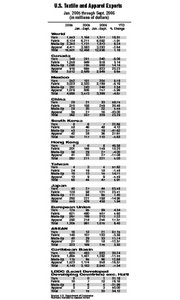2006 Retrospective: China's Gains Aren't as Dramatic as in 2005
No one needed a crystal ball to predict that China would be the top textile and apparel exporter to the United States in 2006.
It’s a trend that has been going on for years, and this year was no different.
During the first nine months of 2006, nearly one out of every three textile and apparel items sold in U.S. stores came from China, according to U.S. Department of Commerce statistics.
But that was only a 7.8 percent increase over the same time period in 2005. In 2005, when quotas went off temporarily for many Chinese-made apparel items, China’s exports to the United States shot up nearly 50 percent.
Still, China exported approximately $21.72 billion in yarns, fabric, sheets, towels, pants, skirts, sweaters, tops and other clothing to the United States from January through September this year. It made up the largest chunk of the $74.7 billion in textiles and apparel that U.S. companies imported from sources around the world.
Mexico hung in there as the No. 2 country sending textiles and apparel to the United States. But its exports paled in comparison to China’s. During the first nine months of this year, Mexico accounted for $5.5 billion in textiles and apparel shipped to the United States, down 10 percent from the previous year.
Despite the Central American Free Trade Agreement being in effect by early 2006, textile and apparel imports from this region declined 8 percent during the first nine months of 2006 compared with last year. The free-trade agreement was expected to boost textile and apparel production in Central America because most goods enter the United States free of tariffs, which can add as much as 35 percent to the cost of a garment. But that didn’t happen.
The 10 countries that make up the Association of Southeast Asian Nations, ranging from the Philippines and Indonesia to Cambodia and Vietnam, came out ahead. Textile and apparel imports from this region, known as ASEAN, were up 16.7 percent, compared with last year, as importers diversified their sourcing strategies so that not everything would be made in China. ASEAN countries sent $11.2 billion in apparel and textiles to the United States—about half of what China exported.
—Deborah Belgum























